If there is a sector which has undergone major changes in the Sahara region so it will be that of urbanization process. Indeed, a comprehensive program to develop patterns of urban development has been started since 1975 in the main cities of the Sahara region. These patterns of urban development are continuously updated to meet the growing needs of people in terms of housing and basic equipment.
The urban state’s strategy the Sahara region has three key objectives:
• The first concerns the resettlement of the most needy families clustered until 1975 in substandard dwellings;
• The second seeks to meet the increasing demand for housing due to population explosion witnessed in major cities of the region and the Kingdom in general;
• The third consists in achieving a balanced and orderly development of urban areas by taking into account the physical and socio-economic specificities of the region.
Since 1976, several emergency programs have been launched to eliminate slum neighborhoods inherited from the colonial period in the cities of Laayoune, Dakhla, Boujdour and Smara.
These emergency programs were followed by social structured housing programs for impoverished or poor populations. Batches of land were also arranged to encourage and induce the beneficiaries to build their own homes.
For example, many housing units smoothly structuring the urban spaces have sprung up in the Sahara region. The construction of these homes was often accompanied by works and paving roads, rehabilitation, restructuring and expansion of wastewater networks and connection to water services, electricity " lighting, and telephony.
The building of residential areas has also been strengthened by the construction of commercial buildings and public utilities: schools, training and qualification centers, hospitals and clinics, sports grounds, young and culture houses...
Infrastructure took a major part in urban development of cities in the region of the Sahara. It include national and provincial highways, ports, airports, connection to water and electricity and telecommunications via optical links with the Agadir based phone centers.
There are also activity areas that house the core cities which gather all socio-professional categories.
Thanks to these urban development plans worthy of modern cities and the willingness Sahrawi of men and women, the Sahara region has been able to become the most promising of the Kingdom with enormous potential in all sectors.
If there is a sector which has undergone major changes in the Sahara region so it will be that of urbanization process. Indeed, a comprehensive program to develop patterns of urban development has been started since 1975 in the main cities of the Sahara region. These patterns of urban development are continuously updated to meet the growing needs of people in terms of housing and basic equipment.
The urban state’s strategy the Sahara region has three key objectives:
• The first concerns the resettlement of the most needy families clustered until 1975 in substandard dwellings;
• The second seeks to meet the increasing demand for housing due to population explosion witnessed in major cities of the region and the Kingdom in general;
• The third consists in achieving a balanced and orderly development of urban areas by taking into account the physical and socio-economic specificities of the region.
Since 1976, several emergency programs have been launched to eliminate slum neighborhoods inherited from the colonial period in the cities of Laayoune, Dakhla, Boujdour and Smara.
These emergency programs were followed by social structured housing programs for impoverished or poor populations. Batches of land were also arranged to encourage and induce the beneficiaries to build their own homes.
For example, many housing units smoothly structuring the urban spaces have sprung up in the Sahara region. The construction of these homes was often accompanied by works and paving roads, rehabilitation, restructuring and expansion of wastewater networks and connection to water services, electricity " lighting, and telephony.
The building of residential areas has also been strengthened by the construction of commercial buildings and public utilities: schools, training and qualification centers, hospitals and clinics, sports grounds, young and culture houses...
Infrastructure took a major part in urban development of cities in the region of the Sahara. It include national and provincial highways, ports, airports, connection to water and electricity and telecommunications via optical links with the Agadir based phone centers.
There are also activity areas that house the core cities which gather all socio-professional categories.
Thanks to these urban development plans worthy of modern cities and the willingness Sahrawi of men and women, the Sahara region has been able to become the most promising of the Kingdom with enormous potential in all sectors.
Laayoune Province
The following satellite photos show urban development in the city of Laayoune since its return to the motherland:

Laâyoune City in 1965

Laâyoune City in 1979

Laâyoune City in 1986
 The different stages of Laayoune's spatial growth 1960-2010
The different stages of Laayoune's spatial growth 1960-2010
The plan below shows the urban development of the city of Laayoune until 2006:

The following tables show the state of town planning documents in the region of Laayoune:
|
Document
|
Target Locality
|
State
|
Next Step
|
|
SDAU
|
-M. Laàyoune - M. El Marsa - C.R Foum El Oued
|
Approved January 21, 2004
|
Appeared in Official Bulletin n°5193 on March 8,2004
|
|
PA
|
-Laàyoune Municipality
|
Under study
|
A conciliation meeting will be scheduled to consider the option
|
|
PA
|
- El Marsa Municipality
|
Under study
|
A conciliation meeting will be scheduled to consider the option
|
|
PA
|
- Tarfaya Municipality
|
Application sent for the opening of public inquiry in 2003
|
Currently, the application is still on standby
|
|
PA
|
- “ El Marsa - Foum El Oued” seaside band
|
Local Concertations
|
The plan is in line for approval
|
|
PA
|
Foum El Oued
|
Under Study
|
Restructuration study has been completed and will be integrated into PA
|
|
P.D
|
- Daoura
|
Approved 29/05/03.
|
The plan was approved on May 29, 2003.
|
|
P.D
|
- Tah
|
Under study
|
The plan is in line for approval
|
|
PAC
|
- Akhfennir
|
Under study
|
Report of the second phase under study
|
|
P.D
|
- Dcheira
|
Under study
|
Under study the justifying report and the development plan.
|
|
P.D
|
- El Hagounia
|
Under study
|
- Center Topographic Survey achieved
|
|
P.D
|
- Boucrâa
|
Under study
|
- PD study underway
|
|
P.D
|
Amigriou boarding point
|
Approved
|
PD study underway
-
|
|
P.D
|
Tarouma fishermen village as integrated project
|
- Local Concertations
|
Project under study
|
|
Document
|
Approved
|
Being Approved
|
Under Study
|
Overall
|
|
SDAU
|
1
|
-
|
-
|
1
|
|
P.A
|
-
|
-
|
6
|
6
|
|
P.D
|
2
|
1
|
4
|
7
|
|
Total
|
3
|
1
|
10
|
14
|
The development the Laayoune city is planned within the framework of a tripartite body composed of three entities:
• Laâyoune as administrative and service pole
• El Marsa as economic and industrial area
• Foum el Oued being the seaside tourist area of the metropolis
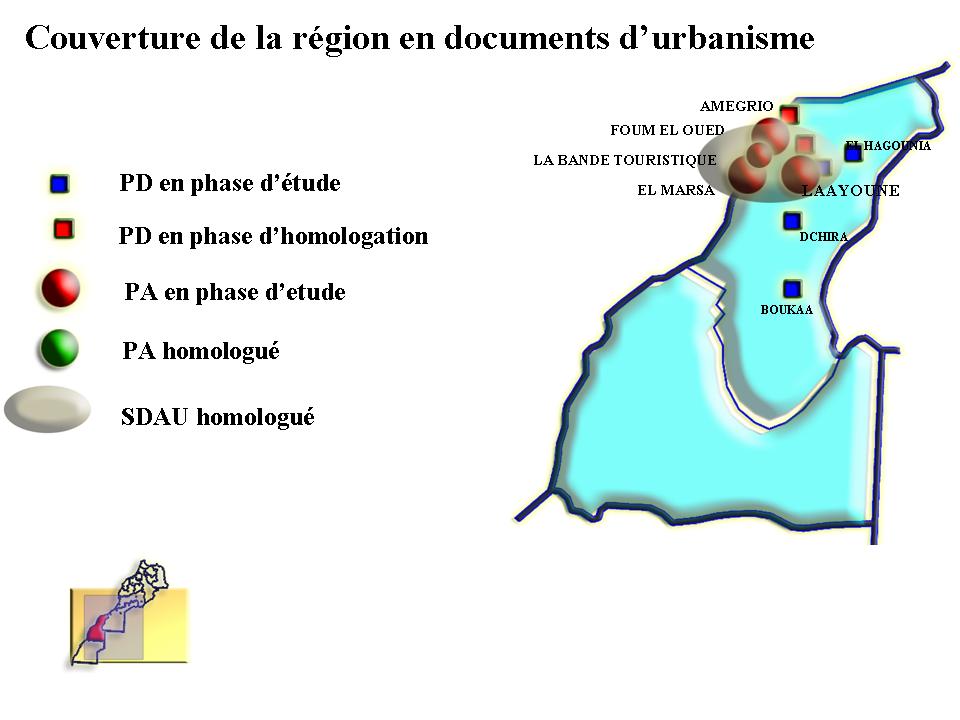
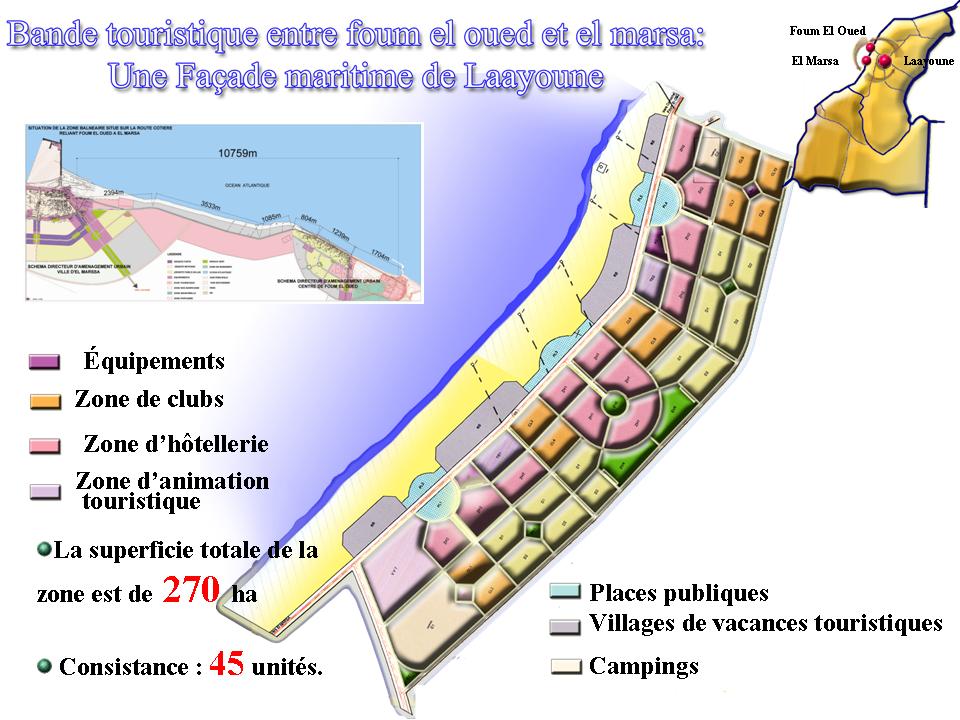
The urban planning activity in the province of Laayoune includes three categories of projects:
• The subdivision operations to be carried out in gradual adjustment zones(ZAP) as part of New Housing Programme in the Sahara region, as presented, on behalf of the Government of His Majesty the King, by Delegate Minister to the Prime Minister in charge of Housing and Urban Development during the session of the Royal Advisory Council for Saharan Affairs (CORCAS) held on December 21-22, 2006 and devoted to the region’s housing sector;
• Other social housing operations to be carried out in various urban centres and rural regions of the Sahara, in the form of subdivisions in gradual adjustment zones(ZAP), or programs to upgrade urban under equipped neighborhoods, including the major urban centres of the South, such as the city of Laayoune;
• Promotional property transactions of subdivision or construction which is a cornerstone of the new strategy for the introduction of a true real estate market locally, which will be based on housing projects with new promotional products, such as economic villas, evolutionary improved housing, Villa parcel and summer housing.
This production will be crowned by the clearance of land units and the involvement of banking institutions in the financing of investments in real estate, as well as buyers.
In the short term, 13 new operations will be launched, covering 30,744 units, including 26,839 lots, 105 economic villas and 3,800 restructuring units at an amount of 1.602,65 MAD. These transactions cover the three above-mentioned categories of projects. The following table shows all these data:
|
Projcet
|
Number
|
Consistency
|
Cost (MAD)
|
Share/Consistency
|
Share/ Cos
|
|
New Housing Project in the Sahara Region
|
4
|
25 815 lots
|
1 465,25
|
84 %
|
91,4 %
|
|
Urban Upgrading
|
2
|
3.800 families
|
24,85
|
12,3 %
|
1,6 %
|
|
Property development
|
7
|
105 economic villas 1024 lots
|
112,55
|
3,7 %
|
7 %
|
|
Overall
|
13
|
30 744 units
|
1 602,65
|
|
Details of these projects are given in the following two tables:
|
Province
|
Operations
|
Localization
|
Consistencies
|
V.I.T
(MAD)
|
|
Lots
|
Com
|
Lots
|
Restructuration units
|
|
Laâyoune
|
New Housing Programme in the Sahara Region
-Madinat Al Wahda (2nd stage) Blocs G, H, I and J
-Madinat Al Wifaq
-Madinat 25 Mars
Urban Upgrading
-Six Districts of Laayoune
|
Laayoune
Laayoune
Laayoune
Laayoune
|
|
|
4 014
10 995
7 606
|
3 200
|
178,50
726,25
395,50
21,85
|
|
Total Laâyoune
|
|
|
22 615
|
3 200
|
1 322,10
|
|
Province
|
Programmes
|
Localization
|
Consistancies
|
V.I.T
(MAD)
|
|
Lots
|
Com
|
Lots
|
Restructuration units
|
|
Laâyoune
|
- Riad I Lotissement
|
Laâyoune
|
|
|
317
|
|
32
|
|
- As Saada Residence
|
Laâyoune
|
53
|
|
|
|
23,85
|
|
- Al Bahr Residence
|
El Marsa
|
52
|
|
|
|
23,40
|
|
- Al Amal I Lotissement
|
El Marsa
|
|
|
100
|
|
4
|
|
- Al Wahda I Lotissement
|
Foum El Oued centre
|
|
|
267
|
|
3,85
|
|
- Ach Chatii I summer Lotissement
|
Foum El Oued beach
|
|
|
190
|
|
13,30
|
|
Total Laâyoune
|
105
|
|
874
|
|
100,40
|
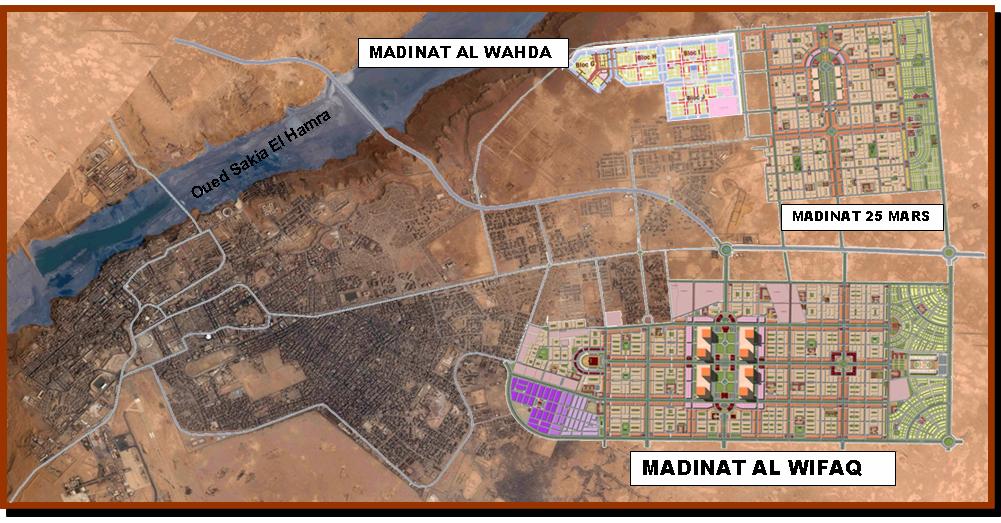
Madinat 25 Mars
Madinat Al Wahda

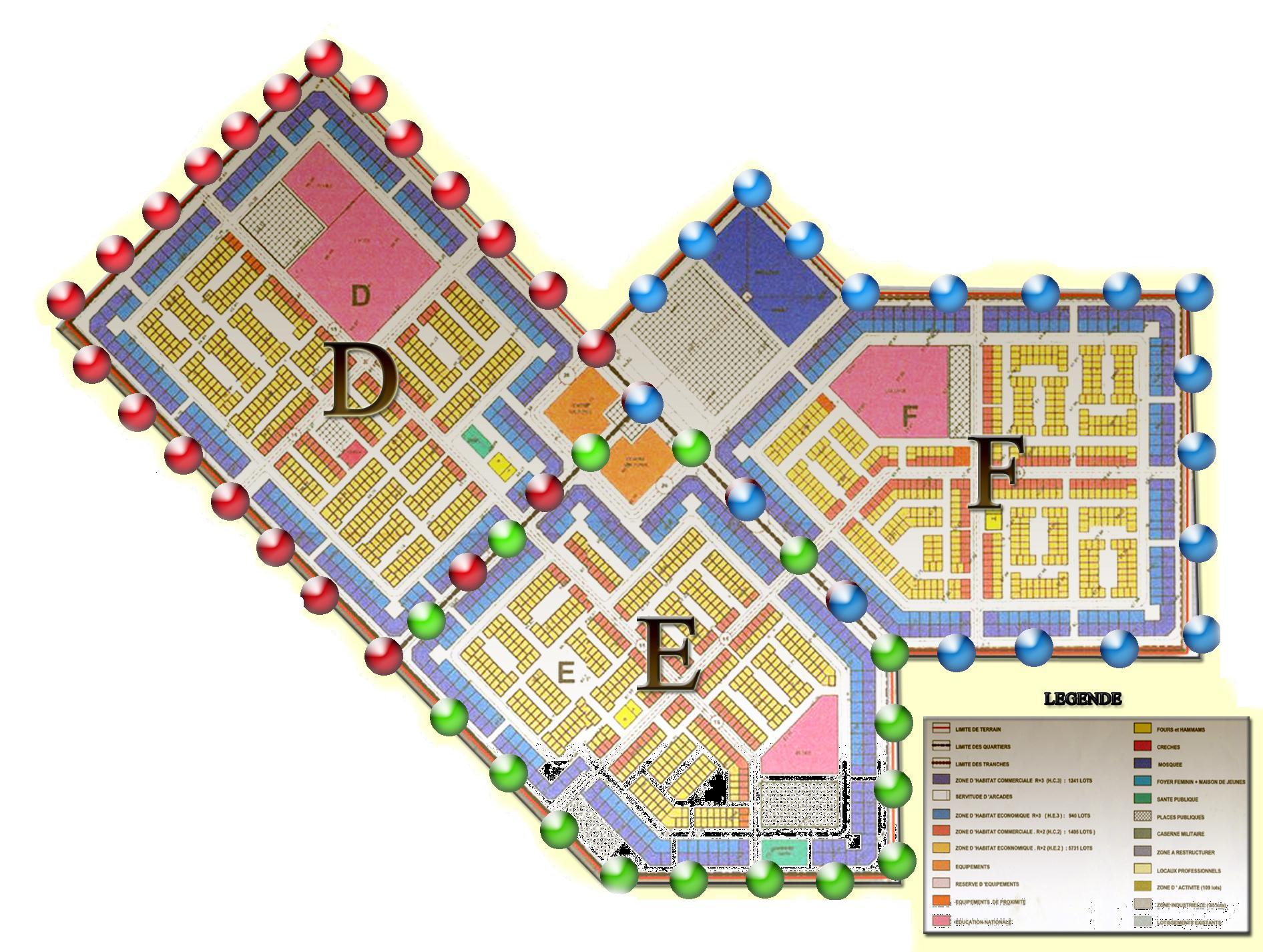


Madinat Al Wifaq
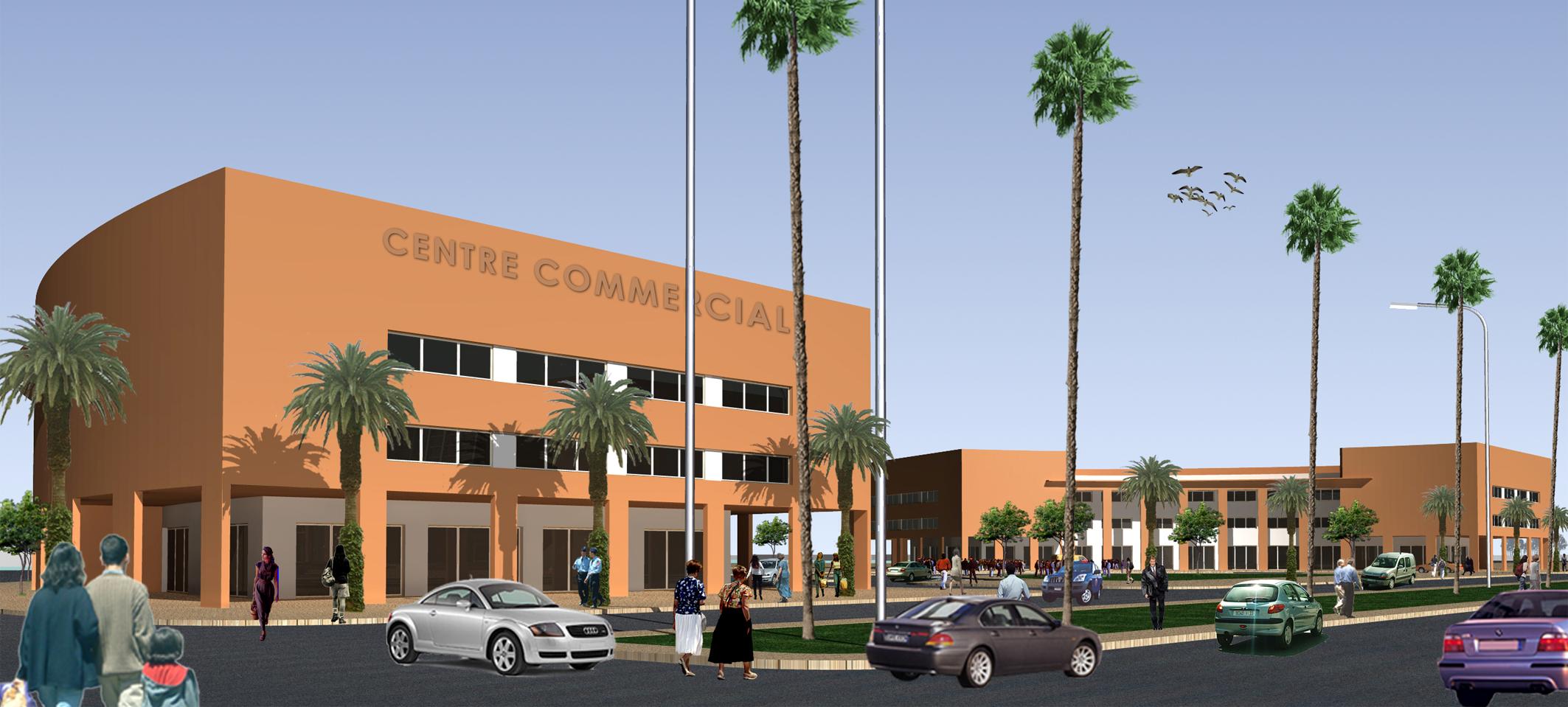
The medium-term planning provides for the development of nearly 1,023 hectares, including 800 hectares to develop Al Marsa and Foumd El Oued communes. The expected consistency amounts to about 7,055 units as shown by the following table:
|
Communes
|
Operations
|
Surfaces
|
Consistancies
|
|
C.U Laâyoune
|
RIAD II villa district- LAAYOUNE and Residence of economic villas AS SAADA II
|
15 ha 41 a 25 ca
|
296 villa percels and 50 economic villas
|
|
C.U Laâyoune
|
Laayoune urban upgrading– banks of Oued Sakia Al Hamra
|
50 ha
|
1 500 families
|
|
C.U Laâyoune
|
Headquarters of Planning Society
OMRANE AL JANOUB
|
30a 88 ca
|
Office Building
|
|
C.U Laâyoune
|
Résidence Administrative de Laâyoune
|
5 ha 50 a
|
150 apartments et 50 villas
|
|
C.R Foum El Oued
|
ZAP Lotissement at Foum El Oued Al WAHDA II
|
7 ha 29 a 48 ca
|
247 parcels
|
|
C.R Foum El Oued
|
ACHATII I summer Lotissement (2nd phase) and ACHATII II summer city
|
2 ha 50 ca
|
200 parcels and 30
bungalows
|
|
C.R Foum El Oued
|
Study of the scheme structure over 400 hectares
Site Extension of Foum El Oued beach
|
400 ha
|
Islets
|
|
C.U El Marsa
|
Study of the scheme structure over 400 hectares
the new city of El Marsa
|
400 ha
|
Islets
|
|
C.U Tarfaya
|
AL MASSIRA ZAP Lotissement
|
10 ha
|
400 parcels
|
|
CU Tarfaya
|
Tarfaya Urban Upgrading
|
60 ha
|
2000 families
|
|
C.R Akhfennir
|
AL OBOUR ZAP Lotissement
|
10 ha
|
400 parcels
|
|
C.U Boujdour
|
LA CORNICHE I villas (2nd phase) and Residence of economic villas
|
20 ha
|
400 parcels
52 economic villas
|
|
CR Jraifia
|
ZAP Lotissement and Public House Service at the center of Ftissate
|
2 ha
|
80 parcels
|
|
C.U Boujdour
|
AL MAJD Lotissement (1st phase)
|
40 ha
|
1200 parcels
|
|
Total
|
1 023 ha 01 a 61 ca
|
7 055 units and arranged islets
|
Dakhla Province
The situation of town planning documents and guidance diagrams are provided below:
|
Document Type
|
Under Study
|
Being endorsed or approved
|
Endorsed or approved
|
Date od endorsment or approval
|
|
SDAU
|
01
|
--
|
--
|
Preliminary Report
|
|
PA Dakhla
|
--
|
--
|
01
|
2000
|
|
PA El Argoub
|
--
|
--
|
01
|
2002
|
|
Open Centers
|
Endorsment or approval
|
Date
|
|
Rural Commune of
Bir Guendouz
|
Approved locally and not opposable to third parties
|
2001
|
|
Labouirda Center (Rural Commune rurale of Imlili)
|
Approved locally and not opposable to third parties
|
2002
|
|
N’Tireft Center (Rural Commune of El Argoub)
|
Approved locally and not opposable to third parties
|
2002
|
The Dakhla planning will increase the new surface area of urbanization to about 1500 ha. This will open approximately 1,119 ha for new urbanization.
This development plan was approved in 2000 (2.99.11.06 decree of March 6, 2000). It is being updated to take into account changes on the ground (derogations in some areas).
Over 1,500 ha, the part reserved to housing is about 456 ha; bringing the capacity of the city to more than 150,000 inhabitants. The areas of activity in all categories account for about 302 hectares, they are divided into 217 ha planned in the port area and 85 Ha planned in the city.

The areas to be urbanized in the short term are equipped with drinking water, electricity and sanitation works are being finalized.
For areas to be urbanized in medium term, works are subjected to connecting the sector to the network of drinking water.